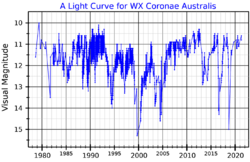Astronomy:WX Coronae Australis
| Observation data Equinox J2000.0]] (ICRS) | |
|---|---|
| Constellation | Corona Australis |
| Right ascension | 18h 08m 50.467s[2] |
| Declination | −37° 19′ 43.21″[2] |
| Apparent magnitude (V) | 10.25 - <16.5[3] |
| Characteristics | |
| Spectral type | C(R5)[3] |
| Variable type | R CrB[3] |
| Astrometry | |
| Proper motion (μ) | RA: 1.421[2] mas/yr Dec.: −7.108[2] mas/yr |
| Parallax (π) | 0.1641 ± 0.0281[2] mas |
| Distance | approx. 20,000 ly (approx. 6,000 pc) |
| Details | |
| Mass | 1.00[4] M☉ |
| Luminosity | 7,400[4] L☉ |
| Temperature | 5,300[5] K |
| Other designations | |
| Database references | |
| SIMBAD | data |
WX Coronae Australis (WX CrA) is an R Coronae Borealis (R CrB) star in the constellation Corona Australis, one of the brightest examples of this extremely rare class of variable star.[7] Despite the rarity, Corona Australis hosts another R CrB star, V Coronae Australis.
WX Coronae Australis is a luminous star with a large excess of carbon and very little hydrogen. It has the spectrum of a carbon star, of type R5 indicating that it shows strong carbon molecular bands but not as red overall as the majority of carbon stars. Its brightness is variable, with 78.9-day pulsations producing changes of about 0.1 magnitudes, as well as occasional deep fades by six or more magnitudes. This classifies it as an R Coronae Borealis variable.[3][8] These stars are likely to have formed from the merger of two white dwarfs into a hydrogen-deficient carbon-rich hot supergiant that then cooled. The deep fades are caused by obscuration by carbon-rich dust condensing around the star.[7][5]
WX Coronae Australis was first reported to be variable in 1928 after it was detected on two different photographic plates at magnitudes 12.2 and 16.0. It was catalogued as HV (Harvard Variable) 4119. The type of variability was not known at the time,[9] but in 1936 its spectrum was measured as R5 and it was tentatively classified as an R CrB star.[10] By 1996 it had been observed to fade 13 times at an average interval of 2,000 days.[11]
References
- ↑ "Download Data". AAVSO. https://www.aavso.org/data-download.
- ↑ 2.0 2.1 2.2 2.3 2.4 Brown, A. G. A. (2021). "Gaia Early Data Release 3: Summary of the contents and survey properties". Astronomy & Astrophysics 649: A1. doi:10.1051/0004-6361/202039657. Bibcode: 2021A&A...649A...1G. Gaia EDR3 record for this source at VizieR.
- ↑ 3.0 3.1 3.2 3.3 "R CrB". https://www.aavso.org/vsx/index.php?view=detail.top&oid=9917.
- ↑ 4.0 4.1 Willingale, Graham A. P. (1989). A theoretical study of the R. Coronae Borealis group of variable stars (Thesis). University of St Andrews. hdl:10023/4656.
- ↑ 5.0 5.1 Clayton, Geoffrey C.; Geballe, T. R.; Herwig, Falk; Fryer, Christopher; Asplund, Martin (2007). "Very Large Excesses of 18O in Hydrogen-deficient Carbon and R Coronae Borealis Stars: Evidence for White Dwarf Mergers". The Astrophysical Journal 662 (2): 1220–1230. doi:10.1086/518307. Bibcode: 2007ApJ...662.1220C.
- ↑ SIMBAD, WX Coronae Australis (accessed 13 July 2014)
- ↑ 7.0 7.1 Tisserand, P.; Clayton, G. C.; Bessell, M. S.; Welch, D. L.; Kamath, D.; Wood, P. R.; Wils, P.; Wyrzykowski, Ł. et al. (2020). "A plethora of new R Coronae Borealis stars discovered from a dedicated spectroscopic follow-up survey". Astronomy & Astrophysics 635: A14. doi:10.1051/0004-6361/201834410. Bibcode: 2020A&A...635A..14T.
- ↑ Lawson, W. A.; Cottrell, P. L. (1997). "The radial velocity variations of cool hydrogen-deficient carbon stars". Monthly Notices of the Royal Astronomical Society 285 (2): 266. doi:10.1093/mnras/285.2.266. Bibcode: 1997MNRAS.285..266L.
- ↑ Woods, Ida E.; Shapley, Martha B. (1928). "Observations and Orbit of a New Eclipsing Binary, H.V. 4159". Harvard College Observatory Bulletin 854: 6. Bibcode: 1928BHarO.854....6W.
- ↑ Swope, Henrietta H. (1936). "Two Eclipsing Variables of Unusually Period, and a Variable with an R5 Spectrum". Harvard College Observatory Bulletin 902: 6. Bibcode: 1936BHarO.902....6S.
- ↑ Jurcsik, J. (1996). "On the Frequency of the Decline Events of R CRB Type Variables". Acta Astronomica 46: 325. Bibcode: 1996AcA....46..325J.
 |


